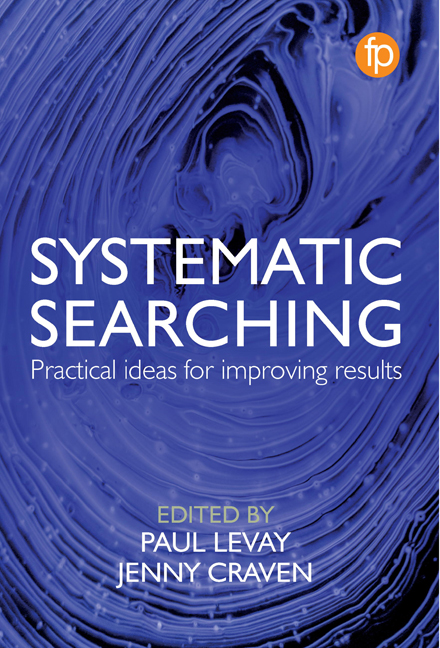Book contents
- Frontmatter
- Contents
- Figures, tables and case studies
- Contributors
- Acknowledgements
- Abbreviations
- Foreword
- 1 Introduction: where are we now?
- 2 Innovative approaches to systematic reviewing
- 3 Searching for broad-based topics
- 4 Choosing the right databases and search techniques
- 5 Gathering evidence from grey literature and unpublished data
- 6 Social media as a source of evidence
- 7 Text mining for information specialists
- 8 Using linked data for evidence synthesis
- 9 Evidence surveillance to keep up to date with new research
- 10 Training the next generation of information specialists
- 11 Collaborative working to improve searching
- 12 Communication for information specialists
- 13 The information specialist as an expert searcher
- 14 Conclusion: where do we go from here?
- Glossary
- Index
1 - Introduction: where are we now?
Published online by Cambridge University Press: 08 June 2019
- Frontmatter
- Contents
- Figures, tables and case studies
- Contributors
- Acknowledgements
- Abbreviations
- Foreword
- 1 Introduction: where are we now?
- 2 Innovative approaches to systematic reviewing
- 3 Searching for broad-based topics
- 4 Choosing the right databases and search techniques
- 5 Gathering evidence from grey literature and unpublished data
- 6 Social media as a source of evidence
- 7 Text mining for information specialists
- 8 Using linked data for evidence synthesis
- 9 Evidence surveillance to keep up to date with new research
- 10 Training the next generation of information specialists
- 11 Collaborative working to improve searching
- 12 Communication for information specialists
- 13 The information specialist as an expert searcher
- 14 Conclusion: where do we go from here?
- Glossary
- Index
Summary
What is systematic searching?
Systematic searching is one of the fundamental building blocks to using evidence in a rigorous way to make decisions on policy and practice. The search is a key component of a systematic review. A review cannot be systematic if it is based on evidence that has been identified through a partial, unsound or incomplete search. We must first discuss what a systematic review is and why the search is so important. This book covers searching for a wide range of topics in the social sciences, however systematic reviewing grew out of the evidence-based medicine movement so let us start there for a definition:
A review of a clearly formulated question that uses systematic and explicit methods to identify, select, and critically appraise relevant research, and to collect and analyse data from the studies that are included in the review. Statistical methods may or may not be used to analyse and summarise the results of the included studies.
(Cochrane, 2018)Evidence-based medicine has been recognised since Archie Cochrane's book Effectiveness and Efficiency: random reflections of health services. Cochrane warned ‘how dangerous it is to assume that well-established therapies which have not been tested are always effective’ (Cochrane, 1972, 29). By the 1990s, the movement was well established in terms of methods, organizations and education (Sackett et al., 1996). Evidence-based medicine meant that decisions would not depend on a doctor trying to read every single study that might be published, they would not be limited to the evidence that a pharmaceutical company or prominent clinician were keen to promote, and they would take into account the often competing or contradictory conclusions from different studies.
The purpose was to develop a set of methods that would provide unbiased ways of comparing one medical treatment to another. It was important to gather evidence on treatments in a systematic fashion so that patients would have the most appropriate care and would not be harmed by the decisions affecting them. A complex set of methods has subsequently been developed to account for sources of bias and to return trustworthy results that show the findings from synthesising the results of multiple studies. As the Cochrane definition shows, this process has to be systematic and explicit.
- Type
- Chapter
- Information
- Systematic SearchingPractical ideas for improving results, pp. 1 - 24Publisher: FacetPrint publication year: 2018



